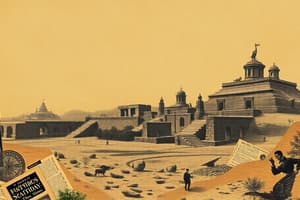Podcast
Questions and Answers
What is the main theme of Shelley's poem 'Ozymandias'?
What is the main theme of Shelley's poem 'Ozymandias'?
- The rise and fall of the Roman Empire
- The beauty of ancient Egyptian architecture
- The importance of preserving historical artifacts
- The transience of earthly power and glory (correct)
What is the form of Shelley's 'Ozymandias'?
What is the form of Shelley's 'Ozymandias'?
- Limerick
- Haiku
- Sonnet (correct)
- Free verse
Which historical figure is referenced in the poem?
Which historical figure is referenced in the poem?
- Ramses II (correct)
- Alexander the Great
- Cleopatra
- Tutankhamun
What is the significance of the broken statue described in the poem?
What is the significance of the broken statue described in the poem?
What aspect of ancient Egyptian history does the poem address?
What aspect of ancient Egyptian history does the poem address?
What does the poem 'Ozymandias' critique?
What does the poem 'Ozymandias' critique?
What does the statue's location in the desert suggest?
What does the statue's location in the desert suggest?
What aspect of ancient Egyptian civilization does the poem explore?
What aspect of ancient Egyptian civilization does the poem explore?
What is the central theme of the poem 'Ozymandias'?
What is the central theme of the poem 'Ozymandias'?
What does the poem encourage the reader to reflect upon?
What does the poem encourage the reader to reflect upon?
Flashcards are hidden until you start studying
Study Notes
Shelley's "Ozymandias": A Poetic Reflection on Ancient Egypt's Urban History
Background
Percy Bysshe Shelley's "Ozymandias," originally published in 1818 under the pseudonym "Glirastes," is a captivating piece that continues to inspire the imagination of readers centuries after its creation. Written in the form of a sonnet, the poem revolves around a powerful image of a fallen monarchy and serves as a reflection on the historical consequences of imperialism and colonialism. Specifically, it critiques the acquisition of ancient Egyptian relics by European powers, particularly Great Britain, and sheds light on the urban history of the region.
The Monument and Its Message
The poem begins with the narrator encountering a monumental statue of Ozymandias, also known as Ramses II, in the middle of a barren desert landscape. The statue, described as "two vast and trunkless legs of stone," represents the remnants of a once proud empire that has succumbed to the ravages of time and decay. The broken statue and its inscription serve as a reminder of the fate of empires and the transience of earthly glory:
"Look on my Works, ye Mighty, and despair!" Ozymandias
This message underscores the idea that all civilizations eventually fade, regardless of the power and grandeur they once possessed.
Historical Insights and Implications
By using a historical figure like Ozymandias, Shelley draws attention to the events leading up to the fall of the ancient Egyptian civilization. At the time, British archaeologists were actively excavating sites in Egypt, where they discovered numerous treasures and artifacts, many of which were taken back to Europe as loot. The poem can be seen as a critique of the British Empire's role in the removal of these artifacts, as well as a commentary on the broader implications of cultural appropriation.
Moreover, "Ozymandias" touches upon the concept of urban planning and the lives of city dwellers in ancient Egypt. The statue's location in the desert suggests that it was once part of a larger complex, possibly a city or palace complex that has since been destroyed. The poem implicitly raises questions about the nature of these urban spaces and the people who occupied them.
Conclusion
In conclusion, "Ozymandias" stands as a timely reminder of the historical and cultural significance of ancient Egyptian civilization and the impact of external forces on its legacy. By examining the poem's themes and imagery, we can gain valuable insights into the urban history of the region and reflect on the role of imperialism and colonialism in shaping our understanding of the past.
Studying That Suits You
Use AI to generate personalized quizzes and flashcards to suit your learning preferences.




